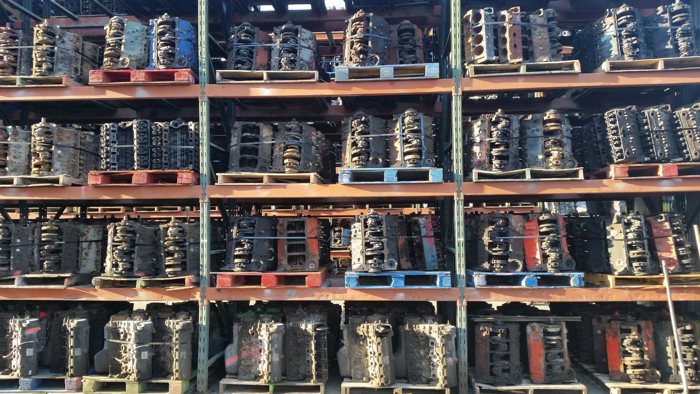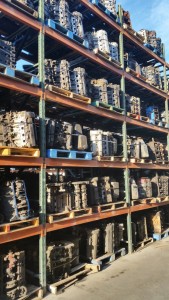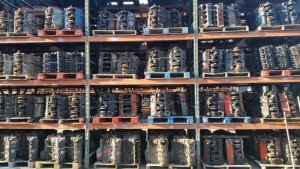 It’s no secret that the engine rebuilding business has changed a great deal in recent years, especially for large production engine remanufacturers (PERs). The days of large production runs of 350 small block Chevys are history simply because the iconic 350 Chevy has been out of production since the mid-1970s. Original engines that have not already been rebuilt once or twice are getting harder and harder to find. There’s still a strong demand for small block Chevy V8s, but not on the scale that it once was.
It’s no secret that the engine rebuilding business has changed a great deal in recent years, especially for large production engine remanufacturers (PERs). The days of large production runs of 350 small block Chevys are history simply because the iconic 350 Chevy has been out of production since the mid-1970s. Original engines that have not already been rebuilt once or twice are getting harder and harder to find. There’s still a strong demand for small block Chevy V8s, but not on the scale that it once was.
“Last year, we did not have a single Chevy 350 in inventory,” said one large midwestern core supplier. “People were calling for Chevy 350s, but we didn’t have any.”
It’s the same story with small block Fords and other once- popular domestic V8, V6 and straight-six engines: most of these engines have been out of production for many years. When scrap iron prices soared a few years ago, many of these engines were scrapped rather than salvaged, creating a shortage of good, rebuildable cores.
With late model engines such as the Chevy LS, Ford modular V8s and V6s and new Chrysler Hemi, the situation is somewhat different. Though relatively plentiful in scrap yards, the thinwall castings that are used in these engines are often cracked or worn out, rendering them unrebuildable. As one core supplier said, “I can buy 10 Chevy LS engines from a scrap yard and find maybe two or three that are rebuildable. The lifter bores are usually bad as are the main bores and cam bores.”
Finding the “right” late model engine cores has also been complicated by the fact that there have been frequent casting and component changes from one model year to the next. Parts may not interchange from one year to the next because the crankshafts, pistons, camshafts, cylinder heads or manifolds are different. Many timing covers and oil pans are VIN specific. This makes it more difficult to buy a pallet of engines and swap parts from ones that are not rebuildable to ones that are.
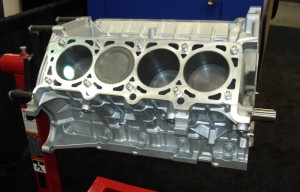
“Twenty years ago, we had maybe 50 different engines in our inventory and we knew every number by heart. Today, there are probably 50 new engine variations every year. That creates a whole new dynamic for core suppliers who are trying to stay current. We have to identify every engine by VIN and vehicle application, computerize our inventory and take digital photos of everything so our customers know they are getting the correct parts,” said another core supplier. “Freight is too expensive these days to be shipping the wrong parts and taking back returns.”
Production engine builders today want engine cores that match a very specific vehicle application. In many cases, they also want the tinware that goes with the engine because the oil pan, valve covers and timing cover are also year, make and model specific. That has changed the way core suppliers have to inventory their stock. Traditionally, most core suppliers only inventoried long blocks, short blocks, bare blocks and heads. Now they also have to inventory engines with complete tinware.
A Dodge Charger and Dakota use essentially the same engine, but they have different oil pans and sumps. Engines that are used in some rear-wheel drive (RWD) applications have different oil pans, timing covers and/or motor mounts than the same engine used in a front-wheel drive (FWD) car. Consequently, you have to be aware of what the differences are and which part numbers fit which applications to source the correct engine.
One large production engine reman told us it currently relies on a dozen different suppliers for its engine cores. It typically buys long block assemblies but also buys complete in many cases to get the correct tinware. Several large PERs also publish engine “want lists” on the Internet, a tactic that has proved to be very successful in obtaining hard-to-find cores.
Newer engines that are only four or five years old can be very difficult to source because most vehicles that are in this age range are still on the road and may be covered by an extended OEM powertrain warranty. Late model engines are also lasting much longer than they once did thanks to fuel injection (less fuel dilution in the crankcase and less fuel dilution on the cylinder walls). So unless a vehicle has been in an accident and totaled by the insurance company, finding a four or five year old engine that’s rebuildable can be a challenge.
Rebuilding Opportunities
The best engine rebuilding opportunities today are V8 and V6 engines for domestic pickup trucks and SUVs. People tend to keep these vehicles a long time and put a lot of miles on their engines. With older, high mileage passenger cars, it’s a different story. If the engine fails, it’s usually cheaper to buy another used car than to replace the engine. And if a vehicle owner does replace the engine, it’s often with a used engine from a salvage yard rather than a remanufactured or rebuilt engine.
For shops that do custom engine rebuilding and performance work, cost is less of an issue. Sourcing engine blocks usually isn’t a problem if you are starting with a new casting or your customer is providing you with an engine that’s rebuildable and complete. However, if you discover an old block is cracked, can’t be sleeved or is worn beyond the point of no return, you’re going to have to find a rebuildable core somewhere or buy a new casting.
Used Engine Risks
Used engine blocks are usually much less expensive than new castings, but are always a risk. Many core suppliers and salvage yards will eyeball an engine for obvious defects before they ship you a core, or even do some simple checks (such as making sure the crank rotates inside the block).
Still these cursory inspection may not show everything – you don’t really know what you have until you tear the engine down, clean everything, examine the block, heads and crank for cracks and straightness, measure the wear in the cylinders, main bores and cam bores, and check main bore and cam bore alignment. There can be a lot of surprises waiting for you inside a used engine. In some cases, you might find the engine will require so much work that it’s less expensive to trash it and find another core, or to buy a new casting.
New original equipment engine block castings are available for many late model engines that are still in production. Another option might be an OEM remanufactured long block assembly or even a complete crate engine. These are viable options for situations where a customer’s original engine can’t be rebuilt or you can’t find a good rebuildable core.
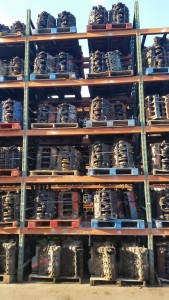
Aftermarket Blocks
Another option is aftermarket blocks. Aftermarket castings still cost more than most salvaged engines but are often more affordable than a new OEM casting – and may be the only option for hard-to-find, high demand engines that are out of production (like Chevy 350s and other popular Chevy, Pontiac, Oldsmobile, Ford or Chrysler engines).
Most aftermarket blocks are cast with performance in mind. These blocks feature thicker cylinder walls and decks, stronger webs and more metal in critical areas where strength is essential for reliable performance. Some include extra head bolt holes around the cylinders for improved sealing with aftermarket heads. Most aftermarket blocks are available with four bolt straight or splayed main caps. Many of these blocks can safely handle well over 1,000 horsepower, with some rated to 2,500 horsepower or even higher.
Another plus with some aftermarket blocks is the availability of taller decks and/or raised cams for building large displacement stroker motors. With these blocks you can build a 427 stroker small block Chevy for about the same cost as a 350.
For racing, lightweight aluminum blocks are the way to go, but these are much more expensive than comparable cast iron blocks. Some aftermarket block suppliers can also custom-machine just about anything you want, from a fully CNC-machined billet aluminum racing block to a modified casting with relocated and/or oversized cam bores, relocated or bushing lifter bores, oversized or sleeved cylinders, custom deck heights, and additional crankshaft clearance for extra long strokers.
You can even buy an aftermarket block that is a hybrid between a traditional small block Chevy on the bottom end (same oil pan configuration, crank, timing cover and motor mount locations) with bolt holes to accommodate late model high flow LS heads on top. This particular block makes for an easy swap into older muscle cars or trucks that were originally equipped with a small block Chevy.
Aftermarket blocks are available from a number of different suppliers. SB/BB Chevy and SB Ford castings are still the ones with the highest sales volume. Chevy LS casting sales have also been increasing as these engines find more and more applications on the street and track. Thanks to a proliferation of aftermarket performance parts for Chevy LS engines, many street rod builders, resto rod builders and muscle car enthusiasts are going with Chevy LS engines in place of SB or BB Chevy engines. Like the SB/BB Chevy and Ford blocks, the Chevy LS blocks are available in aluminum or cast iron with standard or raised deck heights.
One aftermarket supplier of performance engine blocks and heads we interviewed said it will be introducing a new line of affordable cast iron street performance blocks for small block Ford, Chevy and Chevy LS applications. The new blocks will have thicker cylinder walls, thicker decks, reinforced bolt bosses and a reengineered oiling system to improve oil flow to the main bearings. The blocks should be available in time for the SEMA and PRI shows.
Good rebuildable 351 Cleveland blocks have become really scarce. Ford only made the Cleveland engines in the U.S. from 1971 to 1974, although production continued in Australia until the early 1980s. Several years ago, an engineer developed a new cast iron Cleveland block that featured various improvements over the original Ford casting. Unfortunately, he had minimal success marketing the block and eventually sold the rights to the block along with the tooling to an engine builder who plans to reintroduce the Cleveland block later this year as part of a new Cleveland engine parts line. He also said NHRA has already approved the new Cleveland casting for stock and SS classes.
Another new casting recently released for Ford Windsor applications is a tall deck block (9.500 inches) with Cleveland mains, stronger webs and 6-bolt head bolts. Bore sizes include 3.995 inches and 4.120 inches, with sufficient cylinder thickness to be bored to 4.200 inches. The block is clear for strokes up to 4.250 inches. The block also features a higher grade of cast iron that is almost as strong as compacted graphite (over 42,000 PSI).
As automotive engine technology continues to evolve, core suppliers and engine rebuilders are looking at many of today’s “next generation” engines as potential prospects for rebuilding. These include many of the small four cylinder turbocharged engines such as Ford Ecoboost and GM Ecotech engines. Smaller displacement V6 and turbocharged four cylinder engines are replacing many V8s. On some cars all you can get now is a four cylinder. The downsizing is happening because vehicle manufacturers have to meet tough new fuel economy standards in the years ahead.
Some PERs are also looking at expanding the import product lines to include certain popular import engines (like Toyota truck engines as well as certain Subaru and Nissan engines). Japanese engines can be challenging to source because they tend to be even more year, make and model specific than their domestic counterparts.
As for European engines, these can be really tough to source because of smaller production numbers. Most of the applications are high-end luxury cars, although there are some SUVs. As we said earlier, most of the demand these days for reman engines is for trucks and SUVs rather than passenger cars.
Sourcing engine blocks is as much a part of the engine rebuilding business as sourcing pistons, rings and bearings. The block is the foundation upon which everything else depends, so to build a motor right you have to have a solid foundation – and the right core. That, in turn, requires a good working relationship with your core suppliers. No single core supplier can provide you with every engine you need every time, but a group of core suppliers can usually come up with what your are looking for if you make enough phone calls.
One last thing to keep in mind with respect to buying engine cores is freight charges. Iron is heavy and expensive to ship. Freight rates can vary as much as 30 percent from one trucking company to another depending on the routes and schedules. A little shopping around can often net you some significant savings. n
Thanks to World Products (www.pbm-erson.com), Dart Machinery (www.dartheads.com), AA Midwest/EngineQuest (www.aamidwest.com) and Tim Meyer Automotive Machining (www.tmeyerinc.com) for their contributions to this article.

